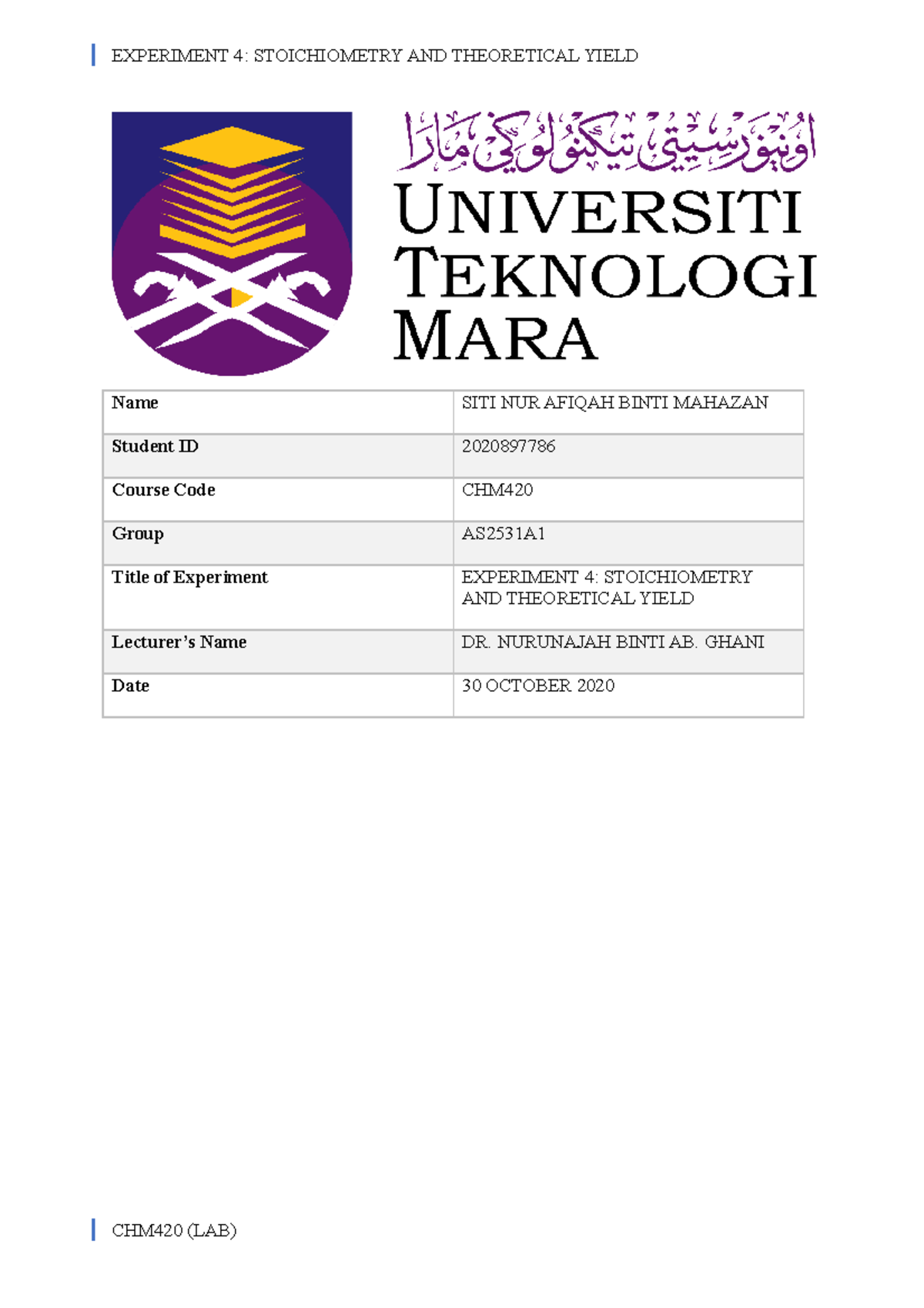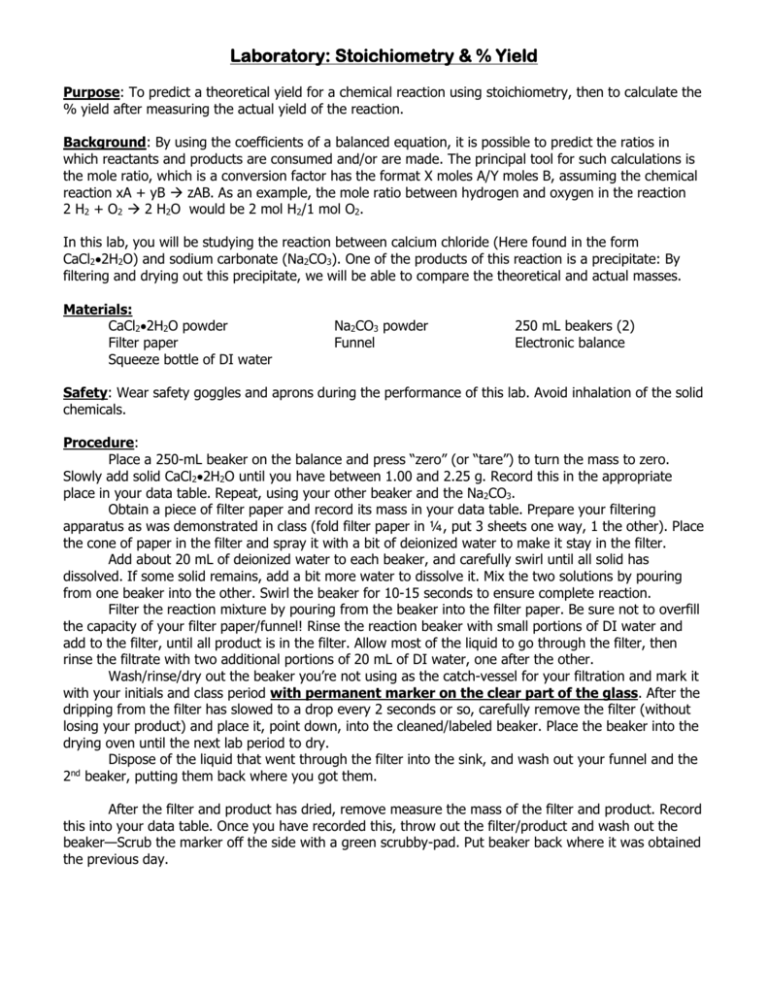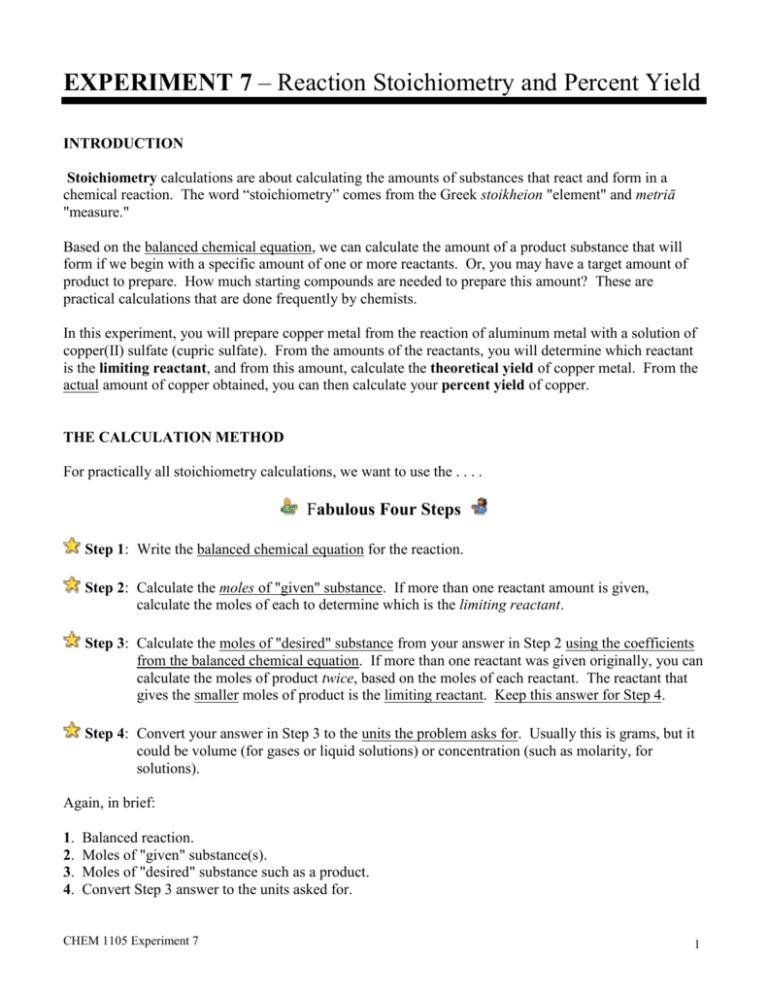Stoichiometry and Theoretical Yield Lab Report
To predict the amount of product generated from a double displacement reaction. The word stoichiometry comes from the Greekstoikheionelement andmetriā measure.

Lab Report Of Experiment 4 Stoichiometry And Theoretical Yield Name Siti Nur Afiqah Binti Studocu
Suppose the reaction produces 107 g of water.

. Bookmark File PDF Lab Report Reaction Stoichiometry And The Formation Of A. We will be adding variable amounts of reactants in a chemical reaction in. Our percent yield for sodium acetate was 78 because the measurements we took of the materials we needed.
In this lab sodium bicarbonate NaHCO 3. B PhysioEx Exercise 12 Activity 4 Fall BIL268 Entire Course - Notes ECO 201 - Chapter 2 Thinking like an economist part 2. Theoretical Yield Definition Formula and Examples.
Experiment 4. Balance the reaction and determine the ratios of reactants to products 2. We call this the theoretical yield.
Given enough information one can use stoichiometry to calculate masses moles and percents within a chemical equation. Determine which reactant is limiting. Up to 24 cash back The percent yield we got from this lab was 78 The calculations we used to find the percent yield are below.
It doesnt even make sense. Steps to calculate theoretical yield. - Investing for Retirement Activity Government Topic 13 Chapter 09 Designing Interventions Nickel and Dimed Worksheet Li Na Chen Part 1 Proposal Speech - Grade.
It is calculated to be the experimental yield divided by theoretical yield multiplied by 100. Practice Homework 23 Theoretical Yield and Percent Yield. Percent Yields Calculate the theoretical yield of ceNaCl for both reactions ref3 and ref4 via standard mass-to-mass stoichiometry.
Yield where the experimental yield closely matches the theoretical yield. In class you have learned how to use stoichiometry to determine the amount of a product generated from a chemical reaction. CHM240 EXP 4 - STOICHIOMETRY AND THEORETICAL YIELD.
3341 076x60 7840 No because the measurements were not exact. Yield - theoretical experimenta 8100 3. Use your masses of sodium bicarbonatecarbonate reactants weighed out in lab as the starting point and the.
Since the theoretical yield was 40 but the actual yield was 39 then the percent yield is 975. Actual yield is the the amount of product actually obtained in a chemical reaction. Lab Report Of Stoichiometry And Theoretical Yield Chemistry.
EXPERIMENT 7 Reaction Stoichiometry and Percent Yield INTRODUCTION Stoichiometrycalculations are about calculating the amounts of substances that react and form in a chemical reaction. Describe one more mistake that would give yield at the Ne conclusion is necessary for this tak North Lake College CHEEM 1405 Stachometry of Chemical Reaction CHEM 1405 Stoichiometry of a Chemical Reaction Lab Stoichiometry Report Sheet with data Name and date. Free DownloadTheoretical Yield Answer Key buffszone com.
Generally the percentage yield of product will be calculated to describe how well the preparation went. The other purpose was to know how the reaction can be balanced and created. Lab report 6 chm420 - for coursework.
A related calculation found in limiting reactant problems is to determine the mass of a. STOICHIOMETRY THEORETICAL YIELD EXPERIMENT. Lab Report 11 - I earned an A in this lab class.
Calculate the moles of product expected if. Stoichiometry and Limiting Reagents Experiment 4 4 - 3 Suppose that one of the 40 finished cars was totaled while it was being loaded onto the tractor trailer. The objective of this experiment is to identify the limiting reactant excess reactant and to determine the percentage yield.
The calculations we used to find this answer are below. Introduction Stoichiometry is a section of chemistry that involves using relationships between reactants and products in a chemical reaction to determine desired quantitative data. The theoretical yield that we get is 10009g while the actual yield is 09009g.
The theoretical yield of a reaction is the amount of product you would get if you use up all of the limiting reagent and if there is no loss. When a compound is dissolved in a solvent the concentration of the compound is usually stated in moles per. Chemistry answer key for percent yield stoichiometry Bing.
STOICHIOMETRY AND THEORETICAL YIELD OBJECTIVE To study about finding the limiting reactant excess reactant and the percentage yield. The purpose of stoichiometry is to be able to calculate and predict how much product can be produced from certain reactants. The percent yield we got from this lab was 5854.
Stoichiometry is the science of measuring of the quantitative proportions or mass ratios in which chemical elements relate to one another. The actual mass of the sodium acetate that we produced in this lab was 24 grams. Stoichiometry and Theoretical Yield Objective To identify the limiting reactant excess reactant and to determine the percent yield.
Calculate the percent yield for each trial. Data Measurement Mass of copper II nitrate 203. INTRODUCTION Stoichiometry is simply the math behind chemistry.
Purpose and Theory The purpose of the experiment is to study and apply the processes of stoichiometric calculation on a controlled chemical reaction. Calculate the theoretical yield of NaCl for each trial. Identifying Chemical Reactions Name_____________________________________________________ Date___________________________ Your text give-and-take identifies four diametrical types of chemical responses section 16-4.
Percent Yield measures the reactions efficiency it is the ratio of the actual yield over the theoretical yield. We used stoichiometry to calculate the. STOICHIOMETRY LAB REPORT Date SHOW ALL WORK ATTACH DATA TABLE 1.
Partner if none write na Data. If any acid spills on you rinse immediately under running water for up to 15 minutes and report the accident to your instructor. The calculations we used to find the percent yield.
Theoretical yield answer key by Itsuo Iwasaki. StoichiometryPercent Yield Lab Purpose. Wear Safety Goggles.
Trial 1 Trial 2 Mass of evaporating. Lab report 7 Bhumi Patel Academia edu. Be especially careful when handling the 6M HCl as it can cause chemical burns to the skin.
Calculate the number of moles of each reactant used. The purpose of this lab is to find the limiting reactant also to find the percentage yield and percentage purity of the reaction that happens between Calcium Chloride and Sodium Carbonate. Stoichiometry lab 1 Purpose.
1193 -1169 24 The expected theoretical mass of the sodium acetate we calculated was 41 grams. The percentage yield is 9001. Other sources identify as many as six types of chemical.
TITLE STOICHIOMETRY AND THEORETICAL YIELD NAME MUHAMMAD SYAMIM BIN NOH STUDENT ID 2020834602 GROUP AS 246 1A CHM JOTTER Reaction 0 M CaCl 2 1 Na 2 CO 3 1. Calculate the mass of sodium bicarbonate that reacts. It is very hard to get measurements to be exact.
Stoichiometry is the calculation of relative quantities of reactants and products in chemical reactions.

Experiment 4 Stoichiometry And Theoretical Yield Experiment 4 Stoichiometry And Theoretical Studocu

Stoichiometry And Percent Yield Lab


No comments for "Stoichiometry and Theoretical Yield Lab Report"
Post a Comment